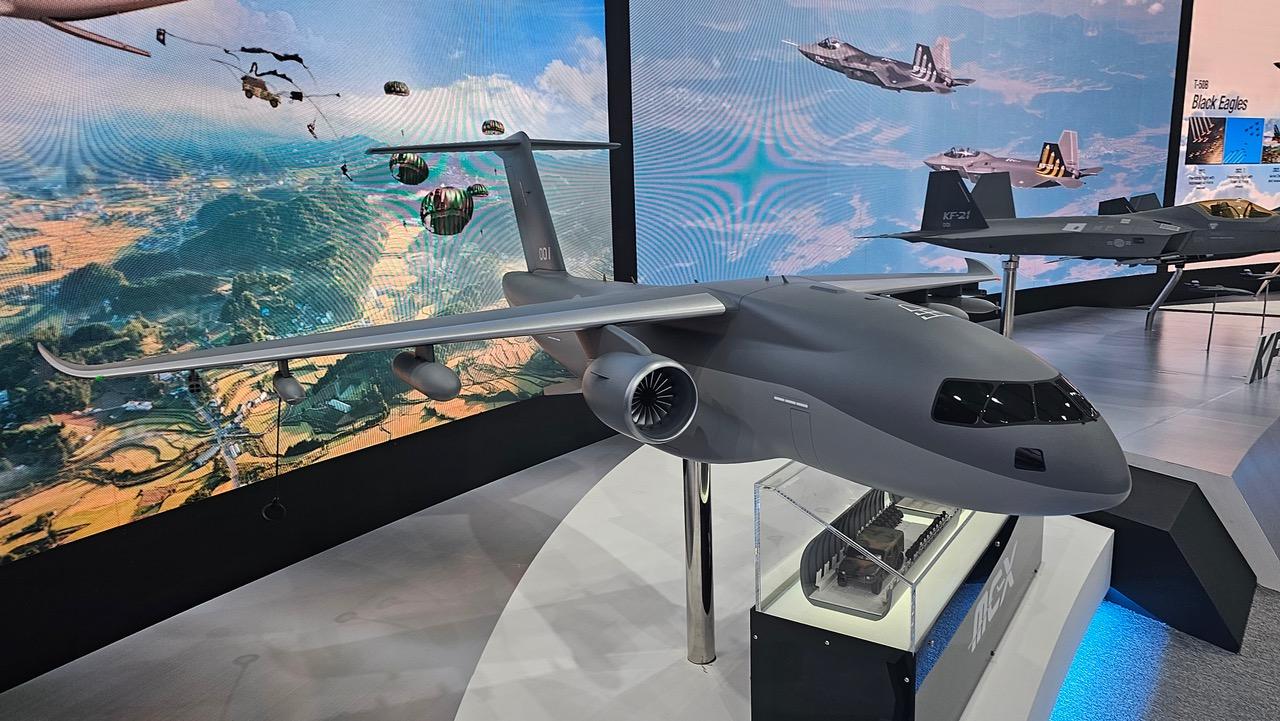KAI Hints At UAS Carrier Capability On MC-X Transport Concept

An MC-X concept on display at ADEX 2023.
SEONGNAM, South Korea—Korea Aerospace Industries (KAI) has revealed the development roadmap for its MC-X transport aircraft program at the Seoul ADEX 2023 exhibition, which hints at a "mothership" role to air-launch uncrewed aerial vehicles (UAV) and rockets for space missions.
Since its first unveiling at the Republic of Korea Air Force (ROKAF) Aerospace Conference in 2021, the MC-X's design and specification has undergone a series of changes. The latest revision envisions an aircraft 40 m (131 ft.) in length with a wingspan of 41 m and a height of 13.5 m. The wing area would be 200 m2 (2,153 ft.2) with an aspect ratio of 7.6 and a main wing sweep angle of 25 deg.
In addition, the number of main landing gear has been increased from 8 to 12 to improve field runway performance.
The MC-X has a maximum payload of 30 tons and a cargo compartment size 3.5-m wide, 3.4-m high and 17-m long, putting it between the Embraer C-390 and Kawasaki C-2 in terms of size.
Under the development roadmap, the first MC-X Block I will primarily be for the tactical transport mission, capable of carrying 92 combat troops or 72 paratroopers as well as cargo.
After Block I, development will focus on aerial-refueling capabilities, using either a probe-and-drogue pod or a boom, which is crucial to refuel the majority of ROKAF assets like the Boeing F-15K and KAI KF-21.
Attention will also turn to the emerging "drone carrier" mission. Under the concept the MC-X would be able to aerially deploy 19 small 150-kg (330-lb.) UAVs that KAI is developing, supporting a greater Manned-Unmanned Teaming (MUM-T) concept that ROKAF is pursuing with KAI.
Aerospace DAILY understands from KAI that these UAS will be air-launched from the MC-X and then link up with and be controlled by fighters such as the FA-50 and KF-21.
Other variants of the MC-X include the "rocket carrier"—or air-launch-to-orbit (ALTO)—for microsatellite missions. A 23-ton launch vehicle would measure around 17 m in length and have a diameter of 3.15 m. South Korea's Agency for Defense Development (ADD) has previously shared plans to conduct a test launch of a 13-m, 16-ton rocket from a C-130J transport aircraft in 2027.
Despite the ambitious plans laid out by KAI, the MC-X is yet to receive official approval from the South Korean government or Defense Acquisition Program Administration (DAPA) to proceed. In January 2023, the South Korean and United Arab Emirates governments signed a memorandum of understanding to jointly develop the MC-X, although cost sharing details are yet to be firmed.
An unnamed industry source told Aerospace DAILY that the MC-X will cost KRW3 trillion ($2.2 billion) to develop.






